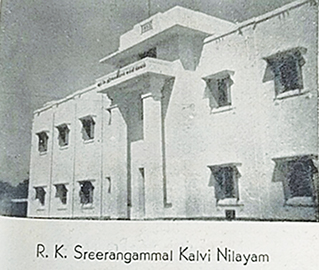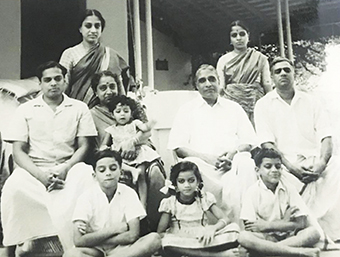Indian education imbibed excellent qualities in the students. Skill was developed without compromising on the right attitude. Teachers taught students from their houses. Some of these students stayed with the teachers. The teacher’s house was the school and the teacher along with his wife were the house teachers those days. Students used to work in the household and also learn. Palm leaf manuscripts were used for teaching and students wrote on sand first. There used to be manuscript copiers too. Teachers used to seek their role. Reading, writing, memorising, interpreting etc., were done in these schools. Tasks, debates and skills based on the ability, acceptance and needs of the students were the order of the day. It was never a one size fit all. This principle stopped at the level of reading, understanding and basic mathematics.
Coimbatore had a similar system too. The villages and the town had such good teachers. They were trusted by the parents. The age of admission varied based on the requirement of the kids. Many of the kids picked up their family tradition along with their education. Both these activities took place, side by side. Kovai Kizhar talks about the old teacher Vadhiyar Vaidhyalingam Pillai who lived in Big Bazaar Street. This amazing bachelor teacher was an epitome of goodness. We get to learn more about education from Sivakavimani C.K.Subramania Mudaliar too in his work ‘Oru Pithanin Kadhai’. This gives us a picture of education in the nineteenth century. Of course the ‘En Sarithram’ of U.Ve.Swaminatha Iyer gives us the best view about education and the types of teachers who were available those days. Again, he saw this changing over time. It was the time when Macualayan system of education came in. Some people say it was thrust upon the society. The debate never ends ! However the best of both could have been recommended. We cannot just produce clerks in our country. Gandhiji and Lala Lajpat Rai felt that India missed out on the modern approach due to colonial rule which was milking the country. A slave country could not pick up like Russia under Peter the Great or Japan after the Meiji Restoration. This was possible because they were free countries. India was severely constricted.
The Thinnai Pallikoodams existed side by side alongwith modern schools which began to come up in the second half of the nineteenth century. Veeraswamy School, Union High School, St.Micheals, Maranna Gowder School, A.S.Rama Rao School etc., came up and did much for education in the modern sense. Sargunam of Union High School worked hard and he felt that the modern system was the best for the numbers had to be met. He did not subscribe to the Gurukulam system. Sarvajana was built by the people of Peelamedu led by the PSG family and it has done a great job. Several Mill owners built schools – Gopal Naidu School, Kadri Mills High School, Rajalakshmi Mills High School, R.K.Sreerangammal School, V.S.Sengottiah School, Adhilakshmi School, Ramalingam Chettiar School, Mani High School etc., Merchants came up with schools like Kikani High School – a school set up by the Kikani family those days. This family were in the textile trade. The ones who did not build schools gave money to the existing schools liberally. We can get to see some photos, stone tablets which proclaim these contributions. P.A.Raju Chettiar, the jeweller was responsible for the old school in Vysial Street and it used to be known as the Gandhi School.
Schooling began with ‘Aksharabyasam’ also known ‘Vidyarambham’ those days. A pooja used to be held and the kid would be made to write a good word by the priest and the parents before it was admitted into a formal school. These affairs were celebrated in a big way. Some of wealthy used it as an opportunity to encourage others to study in schools. Therefore it was accompanied with festivities. Let us today look at the ‘Aksharabhyasam’ that took place at the dawn of freedom in the house of P.A.Raju Chettiar. A pooja was held and it was done by Subburama Iyer, the family priest. All the local relatives would be invited and a nice meal would be served. The kids were dressed in fine clothes. Later the kid used to be taken on an elephant in a procession to school. A slate bordered with gold was used for writing. The chalk holder was also made of gold. Subbulakshmi and Govindarajulu (grand children of P.A.Raju Chettiar) went to school on the same day. An invitation card resembling a betel nut leaf was printed (Jewel Press) and it had their photo on them. Both the kids shared the same event. The evening was an occasion to celebrate and a dance of the famous dancer Kumari Kamala was organised in the family run Raja Theatre. A lot of people were invited for the function. The occasion was celebrated like a wedding reception.
All the kids in the Gandhi School (Arya Vysya School) were given a gift set. This consisted of a bag, a sweet, a slate, a pencil and a picture of God. The teachers were given gifts too. Both the kids began their education after getting blessed by the family, the priest, the relatives, family friends and the teachers. It began on a good note. The kids went to school with a pair of diamond ear studs on their ears. Vyjayanthimala was engaged in order to perform a dance during the Aksharabhyasam of V.Ravindranath (son of P.A.R.Viswanathan Chettiar). The grandest Aksharabyasams were done by this family of jewellers. P.A.Raju Chettiar used to pay the school fees and get books for about 600 kids every year through the P.A.Subbulakshmi Ammal Trust which had been founded after his mother. This practise continued for decades. He was also a leading donor to schools. A lot of classrooms were endowed by him. P.A.Raju Chettiar wanted his community to build schools and colleges in all the districts of the Madras Presidency. It happened over the years.
Many of the schools founded by millowners found favour. A number of kids pursuing their education in the Stanes School moved over to schools like Mani High School and R.K.Sreerangammal in the fifties of the last century. The kids of the mill owners studied with the kids of people belonging to all sections of the society. They spent a lot of time with everyone while growing up. It was not all surprising to see the millowner kid and mill worker kid playing together and studying in the same school.
Several of the rich kids studied in the Municipality Schools too. St.Francis, St.Marys, Presentation Convent, Fathima Convent, Government Training High School did much for girls education. A.T.Devaraja Mudaliar was greatly interest in supporting education. His father Rao Bahadur A.T.Thiruvengadaswamy Mudaliar had created a fellowship for sending deserving kids abroad for higher education. The Devanga weavers had night schools to teach Hindi. It was important for them for it helped them to communicate with their Hindi speaking customers who were found in huge parts of our country. Schools also taught Telugu and Kannada. Sanskrit was taught by scholars. N.S.R.Kanakavalli Ammal, the wife of N.S.Ramaswamy Iyengar (N.S.R road is named after him) did quite a bit for getting women to learn a number of things. She sent a horse drawn cart to pick up women in order to being them to the classes. Teachers like K.S. Ramanatha Iyer (Maths) and T.A.Bhaskara Iyer (Sanskrit & Hindi) did a fantastic job.
The overseas education of industrialists like G.V.Doraiswamy Naidu, R.Venkataswamy Naidu, Prof P.R.Ramakrishnan, Prof G.R.Damodaran, Textool Balasundaram, SITRA K.Srinivasan etc., added to the quality of education. Mill owner S.R.P.Ponnuswamy Chettiar was keen to add to the educational skills of the land. He sponsored the S.R.P. Ammani Ammal Higher Secondary School those days.
The Vivekananda Illam, Devanga School etc., by the weaving community were very helpful those days. Dr.R.K.Shanmukham Chetty was responsible for igniting many in this regard. Prof Subbian, the Principal of P.S.G College of Technology and Vice Chancellor of Bharathiar University was trained abroad and he has done much. The Fowler couple – Alda and her husband Fowler did a lot in Stanes and elsewhere too. Even today the Fowler years are spoken about by the old alumni of Stanes. T.S.Avinashilingam Chettiar, Dr.Rajammal Devadas, G.R.Govindarajulu, Chandrakanthi Govindarajulu, Prof P.R.Ramaswamy, G.D.Naidu were real pioneers. Books can be written about their work. V.C.Vellingiri Gounder supported these initiatives.
V.Radhakrishnan of the Radhakrishna Mills family did a lot to develop the R.V.G higher Secondary School in Kuruchikottai on the outskirts of Udumalpet. He got the best classrooms built and gave fabulous food in the hostel.
Very quickly a number of people from all over began admitting their kids in R.V.G School which was named after R.V.Guruswamy Naidu, the maternal grandfather of Coimbatorean V.Radhakrishnan.
The hostel, infrastructure and quality of education had been of a high order. His mother Kamalam Venkataswamy Naidu was also keenly involved with this school for a long time.
Coimbatore produced very good students, scientists and academicians over the decades. They are many unsung heroes who have to be remembered now.
Amirthan Varadaraj did much for the differentially abled through a centre on Mettupalayam. T.V.M.Thillai needs to be honoured with an award in her name for doing work with the girls in Seva Nilayam.
Industrialists G.K.Devarajulu and N.Mahalingam were given an Honourary Doctorate in the Bharathiyar University which was founded during the governance of M.G.Ramachandran.
G.K.Sundaram did much in the Bharatiya Vidya Bhavan and it added value education to the palate.
Diwan Bahadur C.S.Rathinasabapathy Mudaliar made primary education compulsory during 1933 while serving as the Chairman of the Coimbatore Municipality. It yielded rich dividends for the city. The Miracle on Telugu Brahmin Street brought in the grace they say. Nearly 200 years ago one Venkataramanachar got a message in his dream. Lord Hayavadana came in his dream and asked to be fetched from Udupi. The devout scholar Venkataramanachar who had been associated with Diwan Puraniaya of Mysore, hastened to Udupi and was surprisingly received by the Sodhe Mutt Swamiji and the Tahsildar who had experienced the same dream. They discovered an image of Lord Hayavadana in the Madhwa Saravora at Udupi.
It belonged to era of Saint Vadiraja (1480 – 1600). It was brought to Coimbatore amidst a lot of fanfare. Old timers recall this event as a blessing to Coimbatore. Today Coimbatore is a pioneer in the field of education.
—Rajesh Govindarajulu
The Pioneers, Who Paved The Way For Equality Thru’ Education




